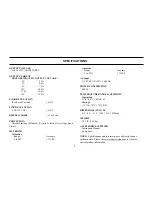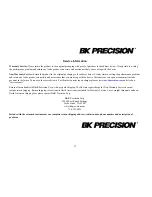
2
TEST INSTRUMENT SAFETY
WARNING
Normal use of test equipment exposes you to a certain amount of danger from electrical shock because testing must sometimes be
performed where exposed high voltage is present. An electrical shock causing 10 milliamps of current to pass through the hear t will
stop most human heartbeats. Voltage as low as 35 volts dc or ac rms should be considered dangerous and hazardous since it can
produce a lethal current under certain conditions. Higher voltage poses an even greater threat because such voltage can more easily
produce a lethal current. Your normal work habits should include all accepted practices that will prevent contact with exposed high
voltage, and that will steer current away from your heart in case of accidental contact with a high voltage. You will signifi cantly
reduce the risk factor if you know and observe the following safety precautions:
1.
There is little danger of electrical shock from the dc output of this power supply. However, there are several other possible test
conditions using this power supply that can create a high voltage shock hazard:
a.
If the equipment under test is the “hot chassis” type, a serious shock hazard exists unless the equipment is unplugged (just
turning off the equipment does not remove the hazard), or the precautions of step 8 are observed.
b.
If the equipment under test is “powered up” (and that equipment uses high voltage in any of its circuits), the power supply
outputs may be floated to the potential at the point of connection. Remember that high voltage may appear at unexpected point s
in defective equipment. Do not float the power supply output to more than 100 volts peak with respect to chassis or earth
ground.
c.
If the equipment under test is “off” (and that equipment uses high voltage in any of its circuits under normal operation),
discharge high-voltage capacitors before making connections or tests. Some circuits retain high voltage long after the
equipment is turned off.
2.
Use only a polarized 3-wire ac outlet. This assures that the power supply chassis, case, and ground terminal are connected to a
good earth ground and reduces danger from electrical shock.
3.
Don’t expose high voltage needlessly. Remove housings and covers only when necessary. Turn off equipment while making test
connections in high-voltage circuits. Discharge high-voltage capacitors after removing power.
(continued on inside rear cover)
Содержание 1686A
Страница 1: ...1 INSTRUCTION MANUAL MODEL 1686A 3 to 14 VOLT DC POWER SUPPLY...
Страница 8: ...8 CONTROLS AND INDICATORS Figure 1 Front Panel Controls and Indicators Model 1686A Figure 2 Rear Panel...
Страница 12: ...12 OPERATING INSTRUCTIONS Figure 4 Connecting Two Power Supplies in Series for a 6 to 28 Volt Output...



































